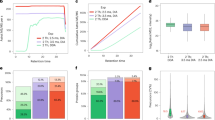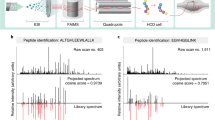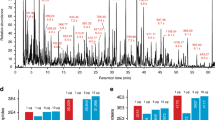Abstract
We describe a mass spectrometry method, QuantMode, which improves accuracy of isobaric tag–based quantification by alleviating the pervasive problem of precursor interference, simultaneous isolation and fragmentation of impurities, through gas-phase purification. QuantMode analysis of a yeast sample 'contaminated' with interfering human peptides showed substantially improved quantitative accuracy compared to a standard scan, with a small loss of spectral identifications. This technique enables large-scale, multiplexed quantitative proteomics using isobaric tagging.
This is a preview of subscription content, access via your institution
Access options
Subscribe to this journal
Receive 12 print issues and online access
$259.00 per year
only $21.58 per issue
Buy this article
- Purchase on Springer Link
- Instant access to full article PDF
Prices may be subject to local taxes which are calculated during checkout


Similar content being viewed by others
References
de Godoy, L.M.F. et al. Nature 455, 1251–1254 (2008).
Ong, S.E. & Mann, M. Nat. Chem. Biol. 1, 252–262 (2005).
Jiang, H. & English, A.M. J. Proteome Res. 1, 345–350 (2002).
Ong, S.E. et al. Mol. Cell. Proteomics 1, 376–386 (2002).
Olsen, J.V. et al. Sci. Signal. 3, ra3 (2010).
Thompson, A. et al. Anal. Chem. 75, 1895–1904 (2003).
Ross, P.L. et al. Mol. Cell. Proteomics 3, 1154–1169 (2004).
Choe, L. et al. Proteomics 7, 3651–3660 (2007).
Dayon, L. et al. Anal. Chem. 80, 2921–2931 (2008).
Lu, R. et al. Nature 462, 358–362 (2009).
Ow, S.Y. et al. J. Proteome Res. 8, 5347–5355 (2009).
Wenger, C.D., Phanstiel, D.H., Lee, M.V., Bailey, D.J. & Coon, J.J. Proteomics 11, 1064–1074 (2011).
Reid, G.E., Shang, H., Hogan, J.M., Lee, G.U. & McLuckey, S.A. J. Am. Chem. Soc. 124, 7353–7362 (2002).
Liang, X. & McLuckey, S.A. J. Am. Soc. Mass Spectrom. 18, 882–890 (2007).
McAlister, G.C., Phanstiel, D.H., Brumbaugh, J., Westphall, M.S. & Coon, J.J. Mol. Cell. Proteomics 10, 009456 (2011).
Ludwig, T.E. et al. Nat. Methods 3, 637–646 (2006).
Lee, M.V. et al. Mol. Syst. Biol. 7, 514 (2011).
Martin, S.E., Shabanowitz, J., Hunt, D.F. & Marto, J.A. Anal. Chem. 72, 4266–4274 (2000).
Geer, L.Y. et al. J. Proteome Res. 3, 958–964 (2004).
Elias, J.E. & Gygi, S.P. Nat. Methods 4, 207–214 (2007).
Cherry, J.M. et al. Nucleic Acids Res. 26, 73–79 (1998).
Kersey, P.J. et al. Proteomics 4, 1985–1988 (2004).
Acknowledgements
We thank A.J. Bureta for figure illustrations, A. Williams for proofreading, A. Ledvina and D. Bailey for assistance with instrument firmware code modifications, S. Hubler for theoretical calculations regarding yeast and human peptides, J. Brumbaugh and J. Thomson for culturing the human cells, and J. Syka, J. Schwartz, V. Zabrouskov, J. Griep-Raming and D. Nolting for helpful discussions. This work was supported by US National Institutes of Health grant R01 GM080148 to J.J.C. D.H.P. acknowledges support from an National Institutes of Health Genomic Sciences Training Program (5T32HG002760).
Author information
Authors and Affiliations
Contributions
C.D.W. designed and performed research, and wrote the paper; M.V.L., A.S.H. and G.C.M. designed and performed research; D.H.P. designed research; M.S.W. and J.J.C. designed research and wrote the paper.
Corresponding author
Ethics declarations
Competing interests
Two patent applications, in part related to this manuscript, are pending: US 13/086638 (C.D.W., D.H.P. and J.J.C. are the inventors) and US 61/471461 (J.J.C. and M.S.W. are the inventors).
Supplementary information
Supplementary Text and Figures
Supplementary Figures 1–9, Supplementary Table 1, Supplementary Note, Supplementary Protocol (PDF 1940 kb)
Rights and permissions
About this article
Cite this article
Wenger, C., Lee, M., Hebert, A. et al. Gas-phase purification enables accurate, multiplexed proteome quantification with isobaric tagging. Nat Methods 8, 933–935 (2011). https://doi.org/10.1038/nmeth.1716
Received:
Accepted:
Published:
Issue Date:
DOI: https://doi.org/10.1038/nmeth.1716
This article is cited by
-
Defining the carrier proteome limit for single-cell proteomics
Nature Methods (2021)
-
Deep proteome profiling of the hippocampus in the 5XFAD mouse model reveals biological process alterations and a novel biomarker of Alzheimer’s disease
Experimental & Molecular Medicine (2019)
-
Benchmarking common quantification strategies for large-scale phosphoproteomics
Nature Communications (2018)



